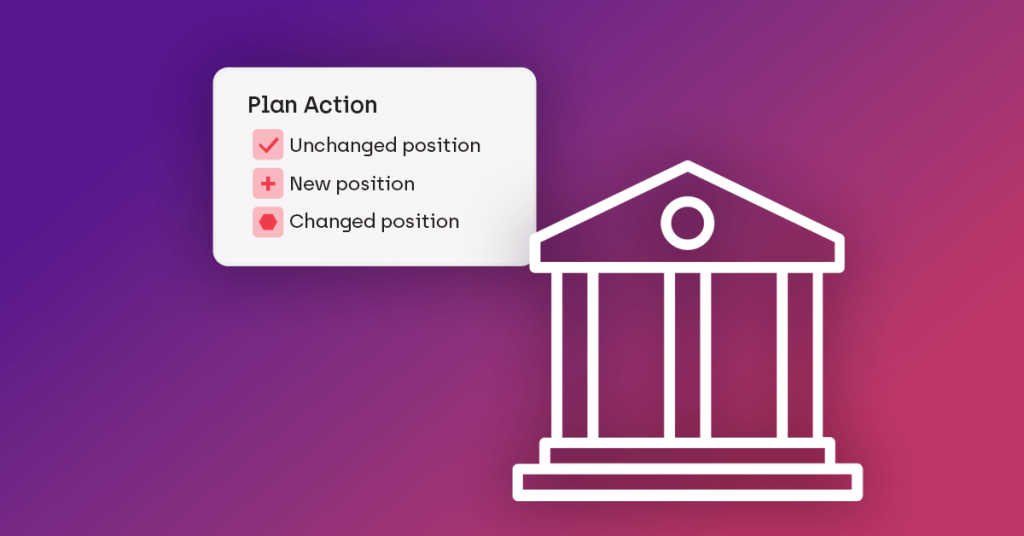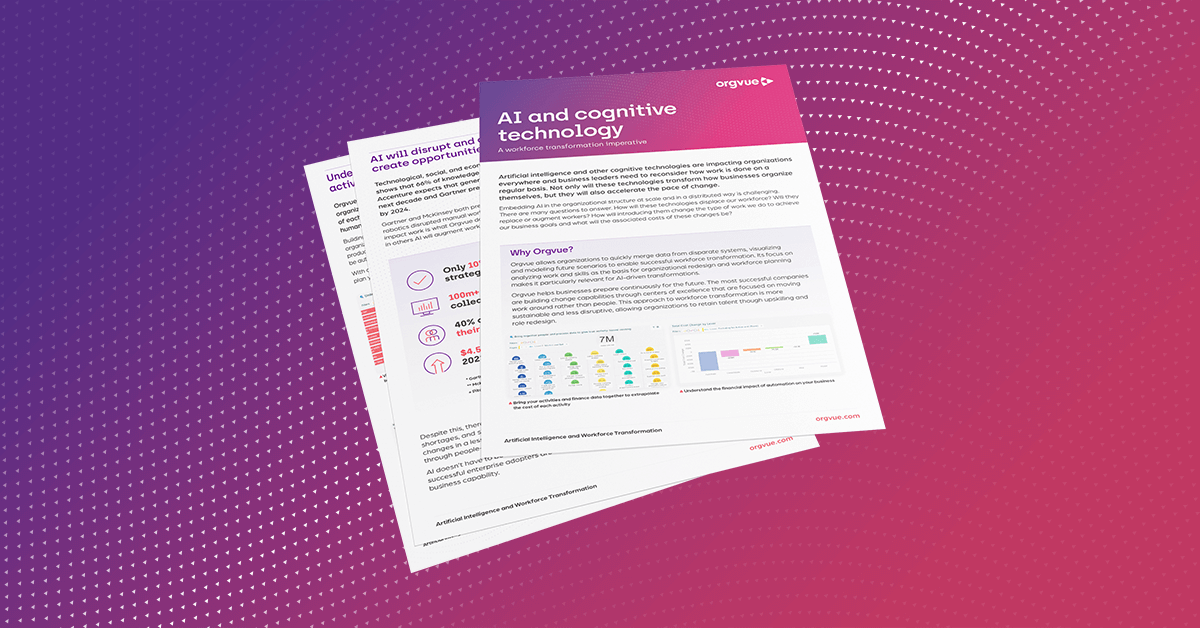Overcoming the challenges of workforce transformation in the public sector
Explore how public sector leaders can leverage data-driven strategies to overcome common pitfalls and enhance organizational effectiveness.
Published by Orgvue
Home > Resources > article > Overcoming the challenges of workforce transformation in the public sector

Workforce transformation is a journey fraught with challenges. Historically, most transformation efforts have fallen short of their goals. In fact, 77% of transformations fail or stall (McKinsey, HBR) and others lose most of their cost benefits through lost talent and productivity.
Despite this, there’s hope on the horizon for business leaders in the public sector. Taking a consistent incremental approach empowers leaders to make informed, data-driven decisions, significantly increasing the likelihood of success.
Purpose-driven workforce design
.Beyond a data-driven approach, clarity of purpose is essential to ensure workforce design aligns with business strategy. By embedding purpose within workforce decisions, leaders can encourage meaningful, lasting change that resonates across the organization and supports long-term alignment.
Organizations are increasingly moving away from large-scale, disruptive transformations in favour of smaller, more frequent changes as part of their routine operations. This shift recognizes that change should be an ongoing, iterative process that has the following benefits:
- Reduced disruption and risk:Incremental changes are typically less disruptive and lower in risk, often yielding better long-term results. This helps reduce transformation costs while allowing organizations to realise benefits more quickly.
- Work-centric models:Shifting from people-centric to work-centric models places focus on activities and outcomes rather than on workforce structure. This promotes continuous organizational effectiveness and enhances customer focus, operational performance, speed, innovation, employee engagement, and overall efficiency.
Common pitfalls to avoid
While attempting transformation, organizations across all industries often encounter several common pitfalls:
- Underestimating costs:Transformations frequently exceed initial cost expectations by a staggering 120%-140% due to unforeseen factors, as reported by Bloomberg.
- Loss of benefits:Many organizations lose the advantages they gain from transformation within 18 months, often because of poor change management, lack of process integration, or a limited understanding of organizational structure.
- Talent replacement issues:The “fire and rehire” approach to talent management rarely produces lasting results, creating further challenges in retaining skilled personnel.
Additionally, employee resistance to change is on the rise, with many choosing to leave rather than adapt. Addressing this resistance through thoughtful change communication and retention strategies is crucial.
Data challenges and workforce analytics
Data-related issues pose a significant barrier to successful transformation in both the public and private sectors. However, change teams often discover that the data challenges they face are not as insurmountable as they at first appear.
- Data foundation strength: If the data foundation is weak, which is commonly the case, starting from scratch with the design may be more effective than trying to reverse engineer flawed data.
- Differentiating data types: Organizations must distinguish between people data and position data to accurately track role vacancies (positions and costs) as a whole. This is vital for obtaining a clear and accurate view of the workforce.
- Building workforce analytics: Though public sector organizations often have to contend with unique structural challenges, good workforce analytics is essential to keeping on top of current and future workforce change.
Rather than allowing these issues to delay transformation, organizations should highlight data quality gaps to executives before work begins. Bringing these gaps to the forefront along with structured support and technology for data cleaning builds a shared understanding of the importance of data foundations.
With executive sponsorship, data quality efforts are more likely to secure the necessary resources and attention, leading to more accurate insights and a stronger foundation for workforce transformation.
Assessing organizational design maturity
At Orgvue, we understand that effective organizational design is critical for successful transformation, especially in the public sector. To help organizations navigate their transformation journeys, we evaluate them using six dimensions of organizational design maturity. This self-assessment often sheds light on areas that require improvement, allowing organizations to strategically focus their efforts:
- Method and approach: How robust is your organizational design methodology to support a data-driven strategy?
- Data: How available and reliable is your organization-related data?
- Technology: How is technology being used to support organizational design initiatives?
- Service delivery model: How well integrated is your organizational design capability with the rest of the organization?
- Execution capability: How capable are you at executing your organizational design methodology?
- Value proposition and executive alignment: How clearly defined is your value proposition and are your business executives actively onboard?
Common organizational design challenges facing the public sector
Across these dimensions, several challenges frequently emerge within public sector organizations:
- Many organizations struggle with a lack of a standard method for best practice organizational design, relying heavily on intuition rather than a data-driven strategy. Additionally, short-term financing hurdles can impede progress.
- Incomplete position data, outdated employee information, and low data accuracy caused by inconsistencies in different data sources can derail transformation projects.
- Not having a way to visualise and track progress through real-time dashboards limits fast, effective decision making and hampers change management initiatives.
- Organizations often find themselves in the early stages of forming a service delivery model lacking a standardized approach for consistent execution.
- Many organizations also struggle with a lack of clarity regarding improvement methods, which can hinder effective execution and lead to inconsistent performance.
- While senior executives may support transformation in principle, agreement may not translate into active endorsement, which can lead to concerns about strategic thinking and the internal perception of organizational design.
By recognizing and addressing these challenges, public sector leaders can enhance their organizational design maturity, paving the way to successful transformations that yield tangible benefits.
Practical insights for successful transformation
To maintain a competitive edge, being able to adapt quickly is essential. Perfection can hinder progress and organizations should begin transformations initiatives even if the details aren’t fully polished. Our key insights for driving successful transformations are:
- Streamline structures: Optimizing organizational structures and enhancing collaboration through improved operational models are vital for success.
- Data visualization: Data and visualization tools are critical enablers. Starting with imperfect data and cleaning it iteratively can lead to enhanced accuracy.
- Define clear metrics: Aligning on global metrics and targets ensures focused transformations, increasing the chance of success.
- Build internal capability: Continuous training for HR business partners and line managers is essential for supporting change efforts.
- Centralized teams: A small, centralized team can provide the processes, training, and tools necessary for local teams to thrive, merging effective transformation practices with local insights.
Building organizational capability
Effective organizational design is not just about org charts; it involves a comprehensive understanding of work across the value chain and integrating people, roles, and skills into a cohesive system, covering:
- Governance and analysis:These are crucial for ensuring designs are delivered and maintained, minimizing the risk of uncontrolled positions.
- Investment in HR:Investment for operational planning is low compared to Finance. Increasing focus on organizational planning is essential for long-term effectiveness and greater influence in decision making.
- Align workforce with activities:This requires regular activity analysis and system-wide alignment to ensure organizational health and sustained productivity.
Bringing all of these considerations into an internal Center of Excellence (COEs) can better support organizational goals, much like FP&A functions support financial planning, by delivering a consistent data foundation for workforce decisions.
Establishing an internal COE or workforce planning function allows organizations to evolve dynamically and align their people strategies with changing needs. This capability equips the organization to respond proactively to transformation demands, fostering resilience and agility.
It’s here that technology becomes important in addressing challenges such as data inaccuracies and inconsistencies between finance and HR data. By centralizing data on a single software platform, organizations establish a single source of truth that enhances decision making and collaboration.
As organizations shift towards more proactive and continuous approach to transformation, embracing data-driven organization design and workforce planning will be essential in achieving strategic objectives. Through these efforts, public sector leaders can navigate the complexities of transformation, enhancing organizational effectiveness and delivering improved outcomes.
AI and workforce transformation
Redefining the work and skills required for your business to thrive.
More resources



